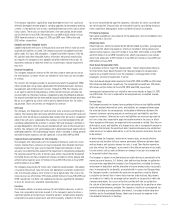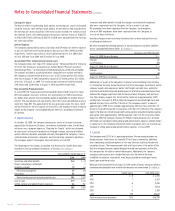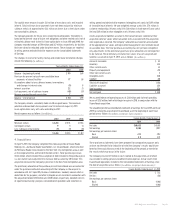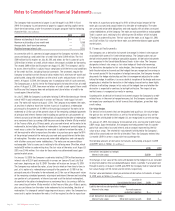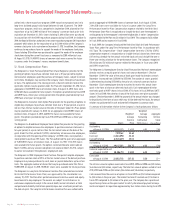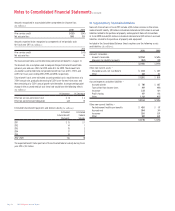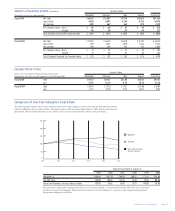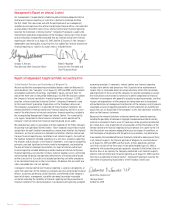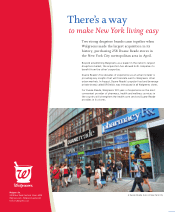Walgreens 2010 Annual Report Download - page 36
Download and view the complete annual report
Please find page 36 of the 2010 Walgreens annual report below. You can navigate through the pages in the report by either clicking on the pages listed below, or by using the keyword search tool below to find specific information within the annual report.
The Company had no commercial paper issued through fiscal 2010. In fiscal
2009, the Company issued commercial paper to support working capital needs.
Short-term borrowings under the commercial paper program had the following
characteristics (In millions):
2010 2009
Balance outstanding at fiscal year-end $ — $ —
Maximum outstanding at any month-end — 1,068
Average daily short-term borrowings — 272
Weighted-average interest rate — 1.51%
In connection with its commercial paper program the Company maintains two
unsecured backup syndicated lines of credit that total $1,100 million. The first
$500 million facility expires on July 20, 2011, and allows for the issuance of up to
$250 million in letters of credit, which reduces the amount available for borrowing.
The second $600 million facility expires on August 12, 2012. The Company’s ability
to access these facilities is subject to our compliance with the terms and conditions
of the credit facilities, including financial covenants. The covenants require the
Company to maintain certain financial ratios related to its minimum net worth and
priority debt, along with limitations on the sale of assets and purchases of invest-
ments. At August 31, 2010, the Company was in compliance with all such covenants.
The Company pays a facility fee to the financing banks to keep these lines of credit
active. At August 31, 2010, there were no letters of credit issued against these credit
facilities and the Company does not anticipate any future letters of credit to be
issued against these facilities.
On July 17, 2008, the Company issued notes totaling $1,300 million bearing an interest
rate of 4.875% paid semiannually in arrears on February 1 and August 1 of each
year. The notes will mature on August 1, 2013. The Company may redeem the notes,
at any time in whole or from time to time in part, at its option at a redemption
price equal to the greater of: (1) 100% of the principal amount of the notes to be
redeemed; or (2) the sum of the present values of the remaining scheduled payments
of principal and interest thereon (not including any portion of such payments of
interest accrued as of the date of redemption), discounted to the date of redemption
on a semiannual basis (assuming a 360-day year consisting of twelve 30-day months)
at the Treasury Rate, plus 30 basis points, plus accrued interest on the notes to be
redeemed to, but excluding, the date of redemption. If a change of control triggering
event occurs, unless the Company has exercised its option to redeem the notes, it
will be required to offer to repurchase the notes at a purchase price equal to 101%
of the principal amount of the notes plus accrued and unpaid interest to the date
of redemption. The notes are unsecured senior debt obligations and rank equally
with all other unsecured senior indebtedness. The notes are not convertible or
exchangeable. Total issuance costs relating to this offering were $9 million, which
included $8 million in underwriting fees. The fair value of the notes as of August 31,
2010, was $1,446 million. Fair value for these notes was determined based upon
quoted market prices.
On January 13, 2009, the Company issued notes totaling $1,000 million bearing an
interest rate of 5.25% paid semiannually in arrears on January 15 and July 15 of
each year, beginning on July 15, 2009. The notes will mature on January 15, 2019.
The Company may redeem the notes, at any time in whole or from time to time in
part, at its option at a redemption price equal to the greater of: (1) 100% of the
principal amount of the notes to be redeemed; or (2) the sum of the present values
of the remaining scheduled payments of principal and interest thereon (not including
any portion of such payments of interest accrued as of the date of redemption),
discounted to the date of redemption on a semiannual basis (assuming a 360-day
year consisting of twelve 30-day months) at the Treasury Rate, plus 45 basis points,
plus accrued interest on the notes to be redeemed to, but excluding, the date of
redemption. If a change of control triggering event occurs, unless the Company has
exercised its option to redeem the notes, it will be required to offer to repurchase
the notes at a purchase price equal to 101% of the principal amount of the
notes plus accrued and unpaid interest to the date of redemption. The notes
are unsecured senior debt obligations and rank equally with all other unsecured
senior indebtedness of the Company. The notes are not convertible or exchangeable.
Total issuance costs relating to this offering were $8 million, which included
$7 million in underwriting fees. The fair value of the notes as of August 31, 2010,
was $1,167 million. Fair value for these notes was determined based upon quoted
market prices.
8. Financial Instruments
The Company uses a derivative instrument to manage its interest rate exposure
associated with some of its fixed-rate borrowings. The Company does not use
derivative instruments for trading or speculative purposes. All derivative instruments
are recognized in the Consolidated Balance Sheets at fair value. The Company
designates interest rate swaps as fair value hedges of fixed-rate borrowings.
For derivatives designated as fair value hedges, the change in the fair value of
both the derivative instrument and the hedged item are recognized in earnings in
the current period. At the inception of a hedge transaction, the Company formally
documents the hedge relationship and the risk management objective for under-
taking the hedge. In addition, it assesses both at inception of the hedge and on an
ongoing basis whether the derivative in the hedging transaction has been highly
effective in offsetting changes in fair value of the hedged item and whether the
derivative is expected to continue to be highly effective. The impact of any
ineffectiveness is recognized currently in earnings.
Counterparties to derivative financial instruments expose the Company to credit-
related losses in the event of nonperformance, but the Company currently does
not expect any counterparties to fail to meet their obligations, given their high
credit ratings.
Fair Value Hedges
For derivative instruments that are designated and qualify as fair value hedges,
the gain or loss on the derivative, as well as the offsetting gain or loss on the
hedged item attributable to the hedged risk, are recognized in current earnings.
On January 27, 2010, the Company terminated all of its existing one-month future
LIBOR swaps. Upon termination, the Company received payment from its counter-
party that consisted of accrued interest and an amount representing the fair
value of our swaps. The related fair value benefit attributed to the Company’s
debt will be amortized over the life of the debt. Then, the Company entered into
six-month LIBOR in arrears swaps with two counterparties.
The notional amounts of derivative instruments outstanding at August 31, 2010
and 2009, were as follows (In millions):
2010 2009
Derivatives designated as hedges:
Interest rate swaps $ 1,300 $ 1,300
The changes in fair value of the notes attributable to the hedged risk are included
in long-term debt on the Consolidated Balance Sheets (see Note 7) and amortized
through maturity. At August 31, 2010 and 2009, the Company had net unamortized
fair value changes of $51 million and $2 million, respectively.
The fair value and balance sheet presentation of derivative instruments at August
31, 2010, were as follows (In millions):
Location in
Consolidated Balance Sheet 2010 2009
Liability derivatives designated as hedges:
Interest rate swaps Accrued expenses
and other liabilities $ — $ 2
Asset derivatives designated as hedges:
Interest rate swaps Other non-current assets $ 44 $ —
Notes to Consolidated Financial Statements (continued)
Page 34 2010 Walgreens Annual Report







